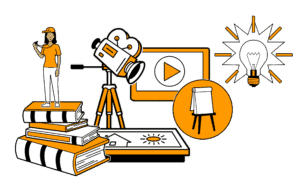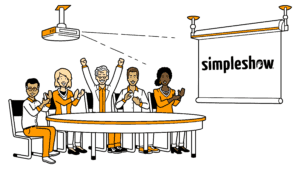Blended Learning – It’s all in the mix!
From The Series Digital Learning
Digital learning approaches such as blended learning are gaining more and more presence. Innovative companies successfully use these technology-based teaching and learning methods to help their employees develop necessary skills and knowledge. Moreover, companies can stand out from the competition and increase attractiveness for potential new employees.
One of the most frequently mentioned new learning techniques is blended learning. Find out what exactly blended learning is and what benefits you can draw from it for your company:


What Does Blended Learning Actually Mean?
Blended learning comes from the English term ‘blender’ and basically means ‘mixed learning’. Often it is also mentioned in the context of ‘integrated learning’ and combines different learning techniques such as ‘micro learning‘, ‘learning on demand’ and so on..
The virtual world of learning meets the analog world of education in blended learning. The new possibilities of digitization, such as interactive online learning, games or explainer videos, are combined with proven face-to-face seminars. The magic word here is ‘linking’: the advantages of both learning worlds are not simply adjacent to each other, but are mixed and structured in such a way that they make sense didactically.
What Are The Advantages of Blended Learning?

Blended learning offers considerable advantages that make this technique particularly attractive for corporate learning. Learning on-demand, especially by video, is becoming increasingly important. The integration of digital learning offers, such as webinars, interactive learning games, or explanatory videos, enables employees to learn flexibly. Mobile and independent of time, it takes the stress out of employees’ time planning. Additionally, information can be accessed in the long term compared to short-term meetings of face-to-face seminars.
Through the selection and combination of different learning models (e.g. games, podcasts, explainer videos) the right approach can be individually defined. The learning offerings can thus be adapted to a specific target group. Respective learning groups, which differ in experience, media competence or hierarchy, are dealt with in accordance with their specific needs. This means that blended learning can be applied to any work area.
The combination with the presence offers also takes social interaction into account. Personal feedback and mentoring play an important role in blended learning.
What Is Important About Blended Learning? – Tips And Tricks
Before putting together the teaching concepts be aware of who the learners are. It is important to define the respective learning target group and find out what is important to them and what are their needs. What is their area of work? What previous knowledge do they have? Which age groups do the learners belong to? What is their position in the company’s hierarchy?
learners are. It is important to define the respective learning target group and find out what is important to them and what are their needs. What is their area of work? What previous knowledge do they have? Which age groups do the learners belong to? What is their position in the company’s hierarchy?
You must set the possibilities framework for the blended learning. What can the company do? What can employees do? For how much time can you plan? Only after setting this framework will you be able to create the perfect mix of online and face-to-face learning methods.

Communicate the finished teaching concept to your employees. Explain to them the purpose of the method in terms of change management instead of throwing them into the cold water. Explainer videos can not only ensure the first assistance, but also get your employees excited about the new concept, increase their acceptance and thus make it easier to get started.
The teacher tries on more of the role of a trainer or a tutor. Face-to-face lessons lose importance. He or she is more responsible for guiding, counseling and providing support for the individual learning pathway.
Blended Learning – What Kind of Combinations Are Possible?
The combination of face-to-face and digital learning environment can follow different approaches. Clayton M. Christensen, Michael B. Horn und Heather Stalker (2013) explain four models for different combinations:
The first model is called the rotation model. It describes a fixed structure with alternating presence and online shares.
In the flex model, learners themselves determine when to ask for face-to-face help or teacher feedback. They have access to the digital learning materials from the beginning.
The blend model describes the substitution of the presence-learning offer by online offer depending on the learners’ own will. Under this model one can take advantage of the online offers. The different methods are therefore not didactically coordinated by the teacher.

The enriched virtual model consists of a purely virtual body. Face-to-face offers at the beginning and in the end complete it.
In this way, blended learning can have many faces and be perfectly adapted to your company.
Do you want to establish digital learning methods in your company? We can help you to successfully implement your video-supported learning resources – tied to your specific topic and your target group! Let our experts advise you!


Henrike Rau is a media scientist and has been working intensively on the topics of the usage of explainer videos in corporate communication and the knowledge transfer since 2015. She writes blog posts for the explainer video pioneer simpleshow and researches use cases and success stories of video usage and storytelling in the digital media. Her special interest is the combination of creative solutions and countable results.